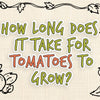Why Are My Tomatoes Not Turning Red? And An Easy Solution
A combination of environmental and physiological factors could be the reason as to why your tomatoes are not ripening.
These factors influence the activity of ethylene which is the hormone responsible for triggering the ripening process. Other factors also play a role in red pigment formation which is related to carotene and lycopene production both of which are triggered by ethylene.
Not Much Time? Skip To What You'd Like To Learn...

Reason Why They Won’t Turn Red
1. Extreme Temperatures
Tomatoes ripen under the optimum temperature of around 70 to 75F.
Within this optimal condition lycopene and carotene are produced in the fruit cells giving the fruit an orange to red pigmentation. When the temperatures exceed these levels, the hormones become denatured, and the process cannot go on.
The lower extreme also has negative impacts on allowing the tomatoes to ripen, whereby, if the temperatures drop below the optimal conditions the hormones will slow significantly or even stop, and you end up with mature green tomatoes which may start to rot as they get old (link).
2. Potassium Shortage
Planting tomatoes in waterlogged or compacted soil can cause reduced potassium levels available for the plants to absorb.
While this can be solved through optimal potassium application rates, the chances are that it will go unnoticed until it is too late. This is because as the plant grows, it does not exhibit any side-effects to the potassium shortage until during the ripening stage when the fruits develop yellow shoulders.
Yellow shoulders refer to uneven ripening of tomato fruits whereby parts of the fruit surface remain green or yellow with the internal, fleshy parts remaining hard and whitish instead of the required reddish hue. Potassium shortage may also lead to blotchy ripening characterized by gray walls which might even collapse as if rotted (link).
3. Exposure to Direct Sunlight
When tomato fruits are too exposed, they not only suffer from sun scalding but also uneven and delayed ripening.
In such a scenario the exposed side usually scalds away and turns yellowish-gray. In some cases, the fruits will develop green shoulders characterized by upper regions near the stem remaining green while the rest of the tomato ripens reasonably well.
If the heat is too much, some tomato varieties especially non-hybrids will develop a conspicuous yellowish hue while the inner parts remain whitish instead of uniform ripening. This is associated with ethylene denaturing (link).
If you're interested in learning exactly how much sun tomatoes need, check out our article here (link).
4. Continued Growth
If your tomato plant is still undergoing robust growth, then the chances are that the already mature fruits will experience delayed ripening due to the high levels of growth hormones in the plant. This condition affects the determinate varieties more than it does the indeterminate ones as these are more genetically enhanced to multiple fruiting stages.
The condition is witnessed when tomato vines have more leafy matter and are still flowering. The mature fruits on such plants not only take much longer to ripen but also receive lower energy supplies as most of it is diverted to the flowers and sustaining the leaves (link).
Methods To Speed Up Ripening

There are steps that you can take to encourage your green tomatoes to turn red on time. These can be classified into two:
1. Encouraging the fruits to ripen on the vine
2. Harvesting the mature green fruits and encouraging them to ripen indoors
Both measures can be approached via a variety of methods with similar outcomes.
The main benefit of maturing on vines is that the fruits develop a more natural and sweeter flavor with even red hues.
Indoors ripening has the added advantage of allowing you to store the fruits for an extended period without the risks involved in waiting for the fruits to ripen on the vine, such as rotting.
Interested In Growing Tomatoes?

At grow your pantry we have developed the perfect tomato cage. It's strong, multitiered, supports growth through all stages, strong and sturdy.
[Check Out The Latest Price Here]
Methods to Speed Up Ripening on Vines

Protect the Vines from Extreme Temperatures
Ethylene will only work within the optimal temperature conditions (70 to 75F).
For this reason, you should consider some form of shading to protect your plants and fruits from either too hot or cold conditions.
Applying mulch with plastic sheeting will also provide some kind of insulation to prevent the soil temperatures from the extremes which would affect nutrient intake and slow down fruit maturity.
Mulching with silver-colored plastic sheeting will also lead to sunlight reflecting off this surface onto the underside of the leafy vines where the fruits are located. This extra sunlight will provide the necessary temperature to encourage faster ripening if your plants are experiencing cold temperatures (link).
Stress the Plant to Encourage Faster Ripening
Tomato plants, just like any other living organism, have the ultimate goal of reproducing to ensure continuity of the species. In tomatoes, this is accomplished by producing fruits which mature and ripen to attract animals which consume and disperse the seeds elsewhere. Stressing the plant sort of hastens this process encouraging the fruits to ripen much faster before the plant dies off.
This can be done by pruning the leaves, although this should not be overdone as it can lead to energy deficiency. You can also stress the roots by gently twisting the crown of the plant triggering the plant into hastened maturity and ripening the already mature fruits. However, this should only be done towards/near season end in indeterminate varieties. Otherwise, you will be missing out on fruit production for the rest of the season.
Reduce Water and Nutrition Supply
If your tomatoes are still not turning red toward the late season, then it’s time to starve the determinate plants slowly. This is best accomplished by reducing water and fertilizer supply as it will encourage the already mature fruits to ripen.
Nitrogen fertilizers that encourage new leaf growth should also be avoided after the fruits have matured as they usually spur leaf growth. This ultimately leads to diversion of energy to the new leaves instead of towards fruits thus slowing down maturity and ripening.
Methods To Speed Up Ripening Indoors

Store the Picked Tomatoes Away from Direct Sunlight
After harvesting your mature green tomatoes, you should store them in cool dry conditions (50F-65F). This not only provides optimal conditions for ethylene production but also hastens the formation of carotene and lycopene giving your tomatoes that lovely reddish color.
The tomatoes should be kept away as it can lead to hardened skin and if it gets too hot, the tomatoes will either overripe or start rotting (link).
Boost The Ethylene Concentration With A Ripe Banana
Ripe bananas produce ethylene gas which will spur the ripening of your tomatoes. To do this simply wrap the tomatoes and a single ripe banana in a newspaper before storing them in your pantry.
Alternatively, you can use a plastic sheet to wrap them but, ensure that you have poked a few holes on it to allow moisture to escape. The same method can be applied using a clay jar; just place your tomatoes in the jar, add a banana and cover the jar.
This method does require monitoring as the ripe banana may begin to rot and spread the damage to your tomatoes.
Hanging Up The Entire Plant
If the frost starts kicking in and your tomatoes are still green, then you can simply uproot the entire vine and hang it upside down in your kitchen. This method should only be used as a last resort and only on determinate varieties which have not only smaller vines but also fruits that mature around the same time.
FAQ’s

Will my tomatoes ripen on the vine?
Yes, if all the conditions required for ripening are met every tomato should ripen on the vine. However, you shouldn’t have to wait that long, as soon as the fruits turn reddish, then they should be harvested and stored if necessary.
Why have they turned yellow instead?
Two main factors can result in yellow tomatoes instead of bright red when ripe.
The first and most obvious one being that your tomatoes are of a yellow variety such as heirloom pear tomatoes.
The other reason could be as a result of low levels of potassium in the soil or an indication of alkaline PH levels.
Do I require any chemicals to ripen my tomatoes?
No, tomatoes will naturally turn red and ripen on their own.
Still want to learn more about growing tomatoes? Check out our Top 15 Tips here (link).
Other Articles You'll Love...
15 Tips For Growing Tomatoes
What Causes Tomato Leaves To Curl?
How Much Sun Do Tomatoes Need?
Why Are My Tomatoes Not Turning Red?
How Far Apart To Plant Tomatoes
Why Are My Tomatoes Splitting?
-
Posted in
tomatoes






